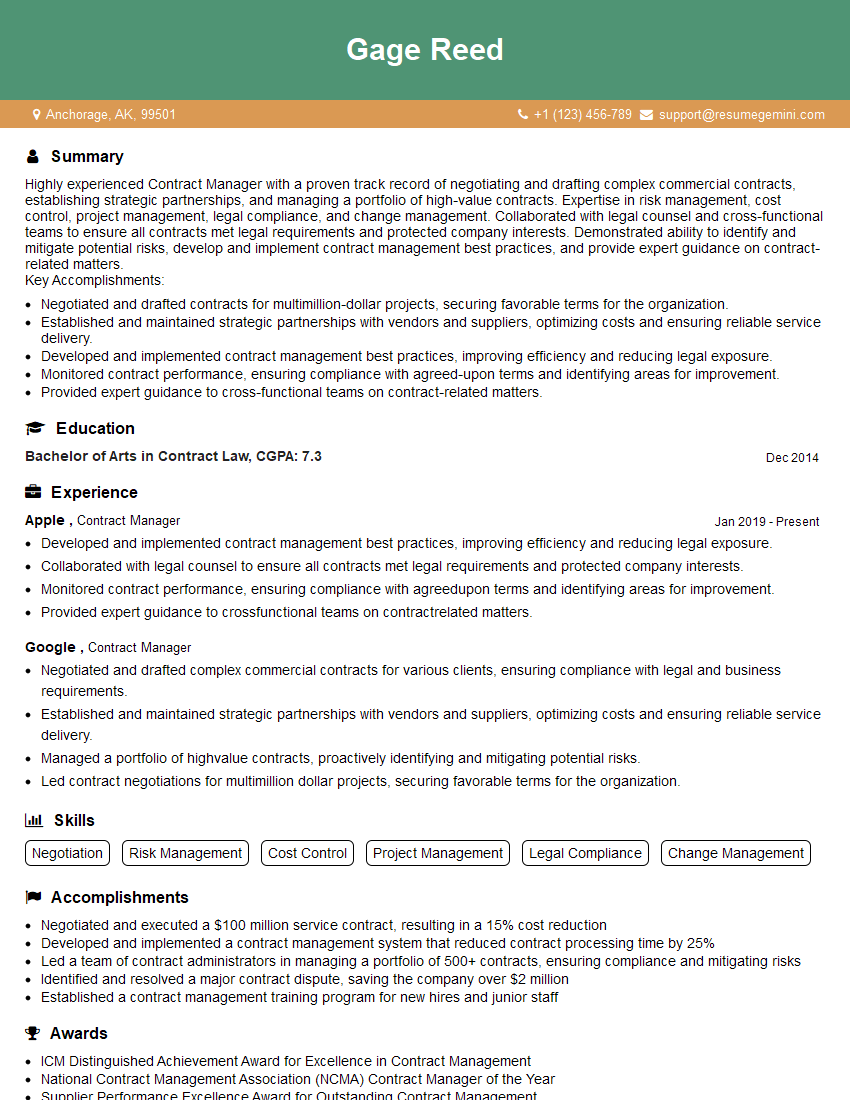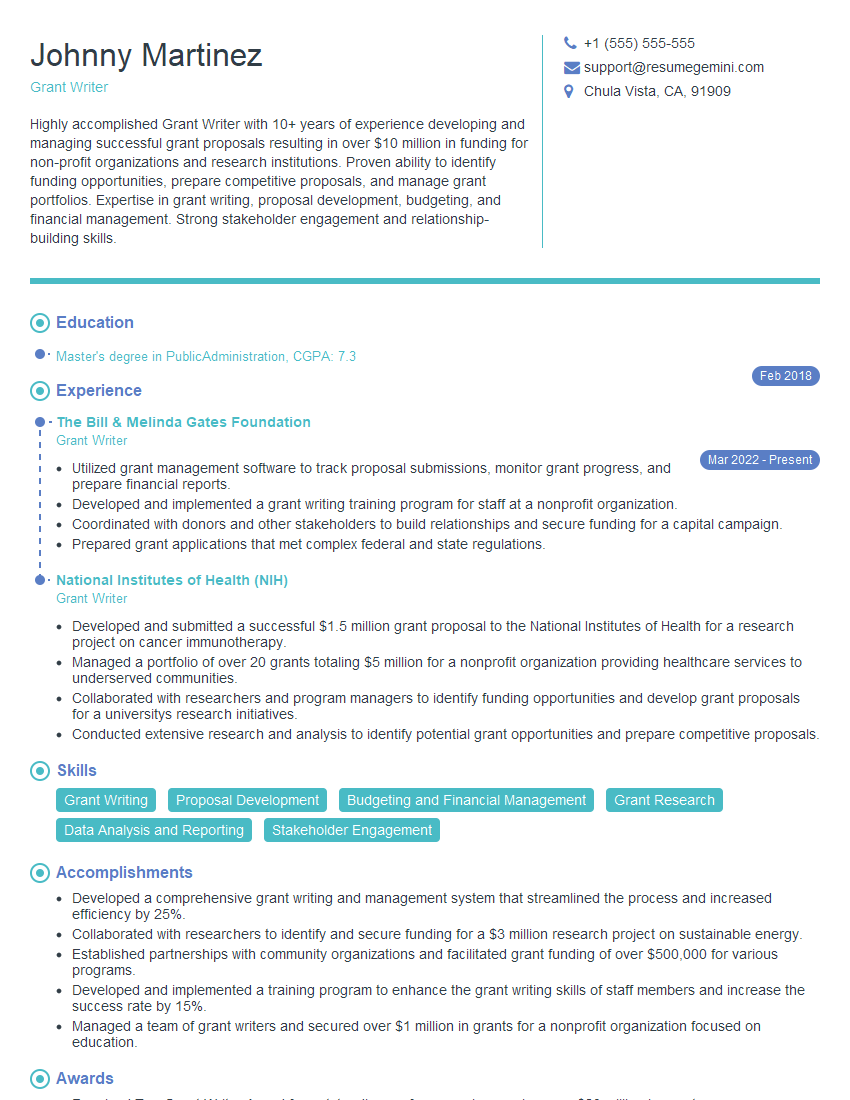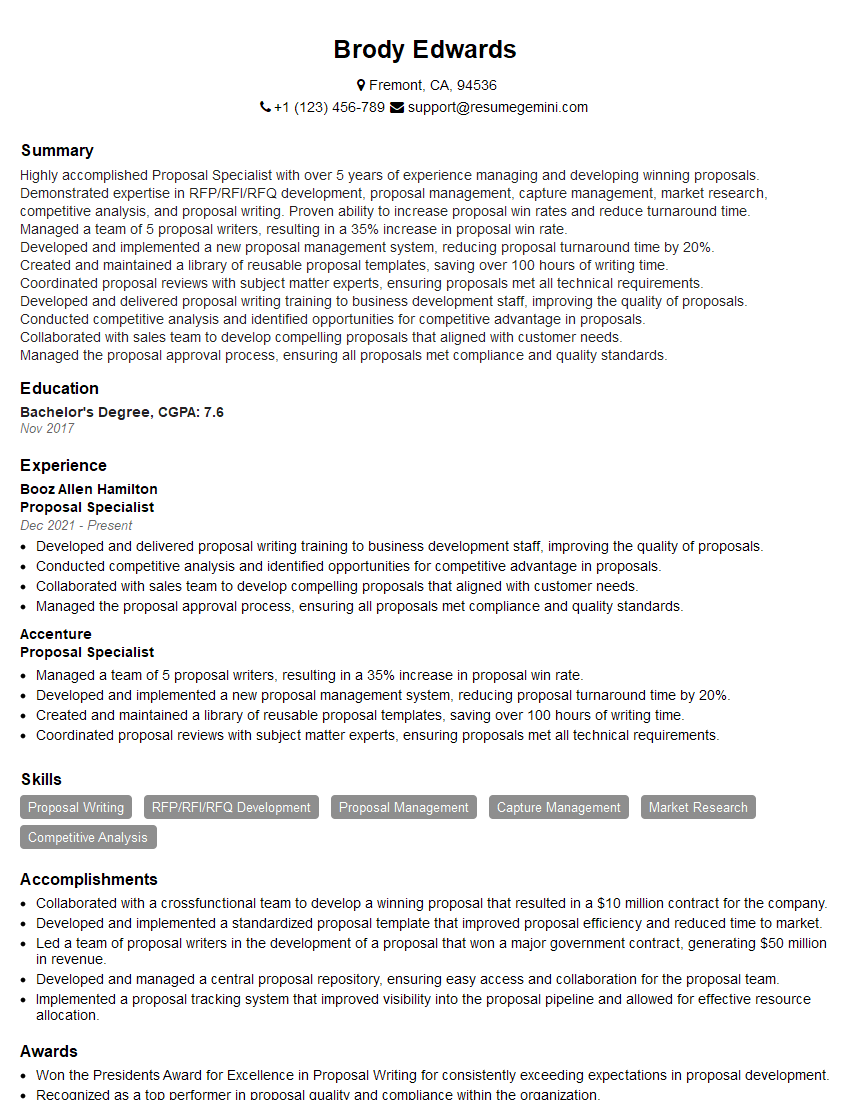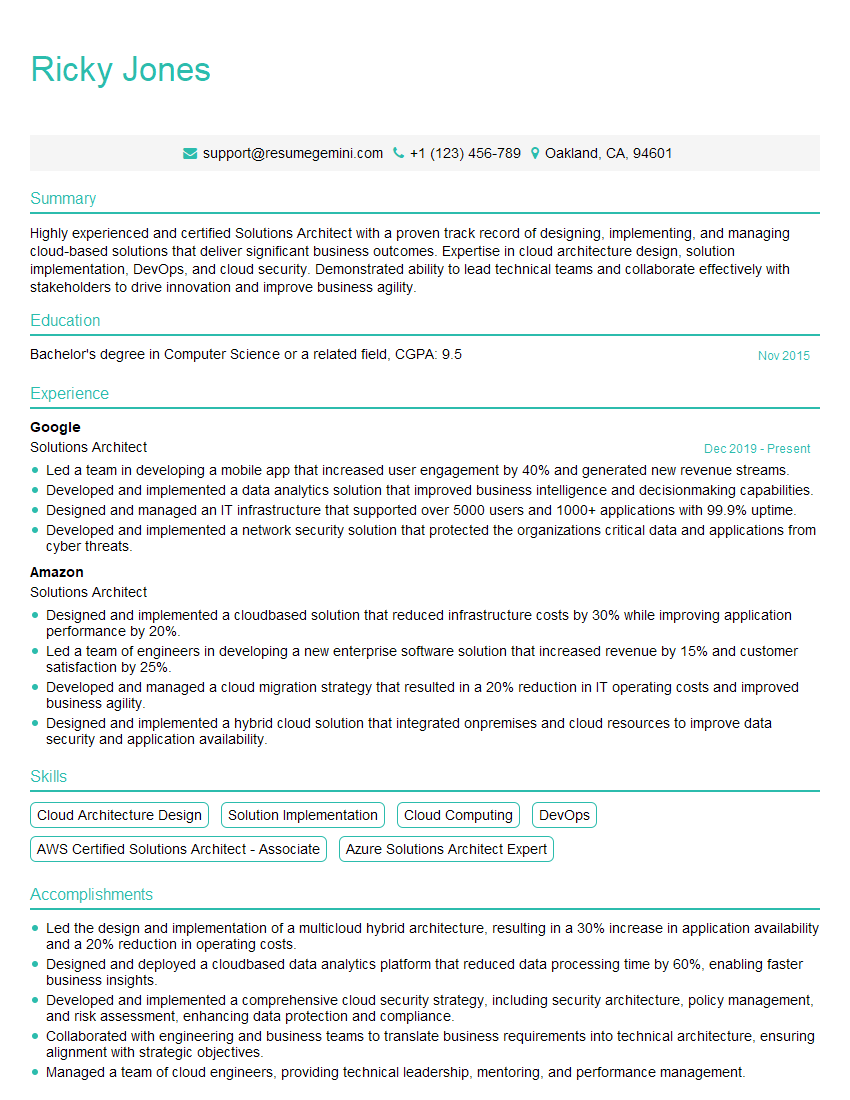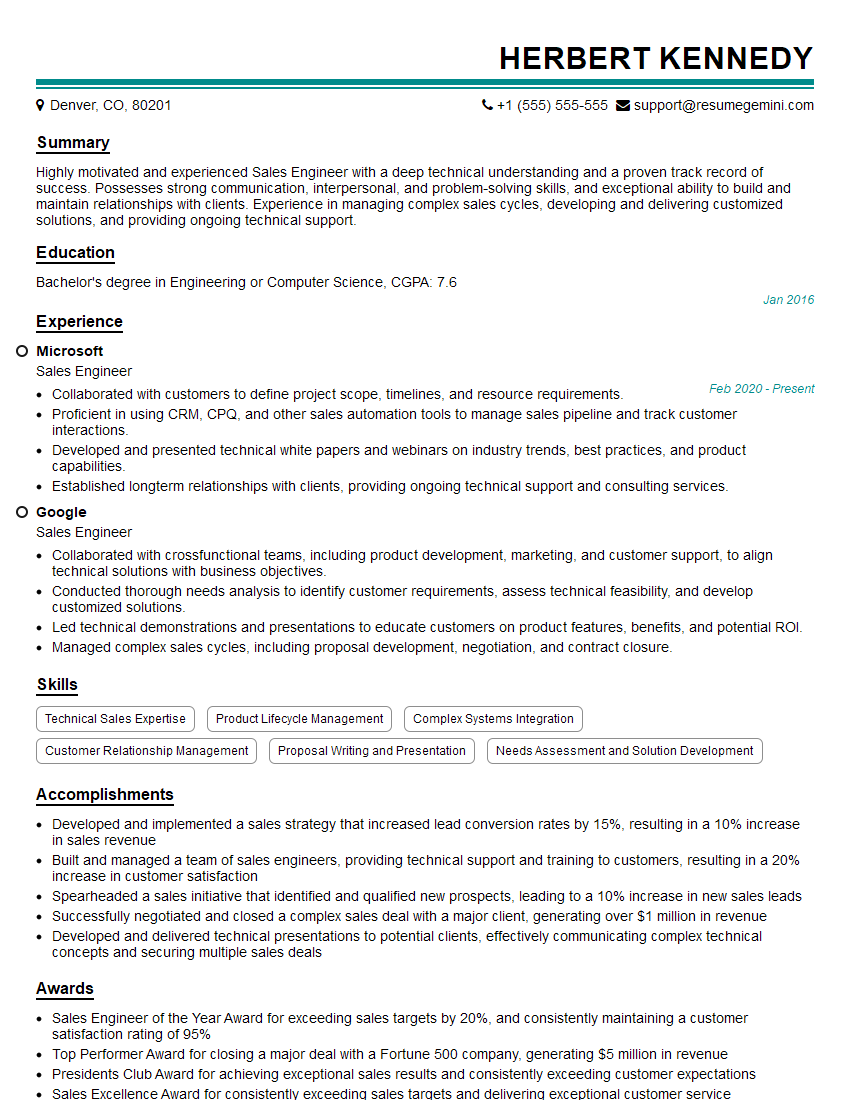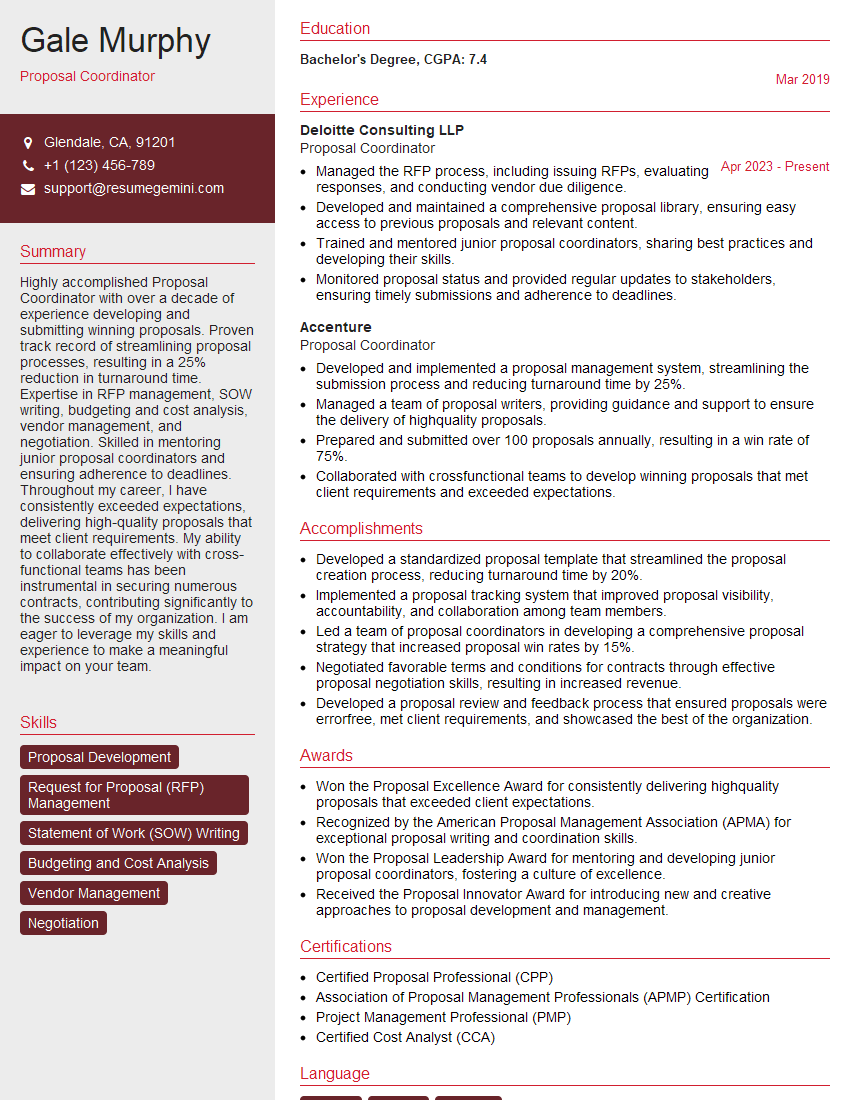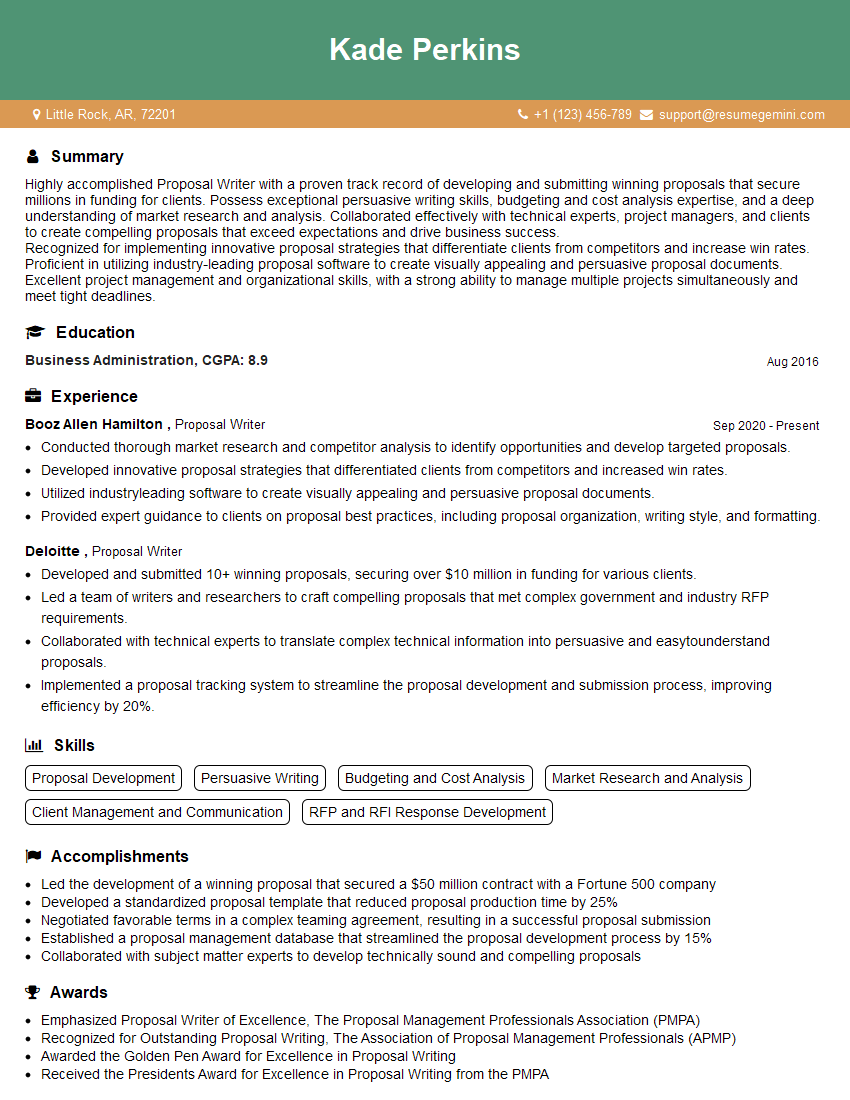Feeling uncertain about what to expect in your upcoming interview? We’ve got you covered! This blog highlights the most important Proposal Writing and Pitching interview questions and provides actionable advice to help you stand out as the ideal candidate. Let’s pave the way for your success.
Questions Asked in Proposal Writing and Pitching Interview
Q 1. Explain your process for researching and understanding client needs before writing a proposal.
Understanding client needs is paramount before even thinking about writing a proposal. My process begins with thorough research, involving several key steps. First, I analyze the Request for Proposal (RFP) or any initial communication meticulously, noting specific requirements, desired outcomes, and potential challenges. This is akin to studying a blueprint before building a house – you need the foundation.
Next, I conduct independent research into the client’s industry, their current market position, and their past projects. This might involve reviewing their website, publications, news articles, and social media presence. Think of it as understanding the client’s landscape before suggesting a solution. This step provides context and helps me tailor the proposal to their unique needs.
Finally, and critically, I often engage in direct conversations with key stakeholders – whether through phone calls, emails, or meetings. This allows me to clarify ambiguities, ask clarifying questions, and gain deeper insights into their priorities and concerns. A direct conversation is crucial; it helps to bridge any gaps between assumptions and reality. For example, if the RFP mentions ‘improving efficiency,’ I might ask what constitutes ‘improvement’ to the client, and what metrics they’ll use to measure success.
Q 2. How do you tailor a proposal to a specific client’s requirements?
Tailoring a proposal is not just about inserting the client’s name; it’s about deep personalization. It begins with addressing the specific problem or opportunity identified in my research. For instance, if a client is struggling with low employee engagement, the proposal won’t be a generic template for ‘improving morale’; it will directly tackle the specific reasons for low engagement identified during my research phase.
I use language that resonates with the client, mirroring their style and tone. A startup will respond differently to a proposal than a large corporation, so I adjust my vocabulary and approach accordingly. I also strategically highlight the aspects of my proposed solution that directly address their concerns, showcasing a clear understanding of their unique challenges. For example, if their RFP highlighted budget constraints, I would focus on the cost-effectiveness of my proposed solution, even quantifying the return on investment (ROI).
Finally, I use case studies and examples that are relevant to their industry and past experiences, providing concrete evidence of how similar clients achieved success using my services or products. This shows I’ve done my homework and truly understand their needs and aspirations. It’s about demonstrating that I am not just selling a product; I’m offering a tailored solution to their specific problem.
Q 3. Describe your experience with different proposal formats (e.g., narrative, comparative).
My experience spans a variety of proposal formats. The narrative format is ideal for showcasing a compelling story, ideal for creative or design-focused proposals. It focuses on building a narrative around a problem and your solution, making it engaging and memorable. Think of it like storytelling for business. I’ve used this for proposals involving branding strategies and marketing campaigns.
Conversely, the comparative format excels when highlighting the strengths of your proposal against competitors. This involves a structured comparison, usually using a table, which shows how your offering outperforms alternatives. This is particularly effective in bids for government contracts or situations where several providers are competing. For example, I’ve used a comparative format when proposing software solutions, highlighting key features and pricing in contrast with competitors.
I also leverage a blended approach, combining elements of both narrative and comparative formats where appropriate, creating a flexible structure that caters to specific client needs and project requirements. This versatile approach ensures that the proposal effectively communicates the value proposition regardless of the context.
Q 4. How do you ensure your proposals are persuasive and compelling?
Persuasive and compelling proposals are built on several pillars. Firstly, strong evidence is crucial. This involves data-driven arguments, quantifiable results, and robust case studies. Instead of saying ‘we improve efficiency,’ I’d say ‘we improved client X’s efficiency by 15% within six months, as evidenced by a reduction in processing time from Y to Z.’
Secondly, clarity is key. The proposal must be easy to understand, even for those who aren’t experts in the field. I use clear and concise language, avoiding jargon and overly technical terms. I also structure the proposal logically, using headings, subheadings, and bullet points to improve readability.
Thirdly, a compelling narrative is essential. The proposal should tell a story—a story about the problem, your proposed solution, and the positive outcomes for the client. This involves building rapport, demonstrating empathy, and creating a connection with the reader.
Finally, strong visuals can significantly enhance persuasion. Charts, graphs, and images help to illustrate key points and maintain reader engagement.
Q 5. What strategies do you use to highlight the value proposition of your offerings?
Highlighting the value proposition requires a shift in perspective from ‘what you do’ to ‘what you achieve for the client.’ Instead of focusing on features, I emphasize the benefits those features deliver. For example, instead of saying ‘our software has a user-friendly interface,’ I’d say ‘our software’s intuitive interface will reduce training time for your employees by 50%, saving you both time and resources.’ This is a tangible benefit that the client can readily grasp.
I use quantifiable metrics to demonstrate the value of my offerings. This could involve calculating ROI, projecting cost savings, or demonstrating an increase in revenue. Solid numbers are powerful persuasive tools. I also include testimonials and case studies to show how my solutions have helped similar clients achieve their goals. These real-world examples add credibility and build trust.
Finally, I focus on solving the client’s specific problem, not just selling my services. By clearly demonstrating how my offering addresses their pain points and aligns with their objectives, I make a strong case for its value.
Q 6. How do you manage competing priorities and deadlines when working on multiple proposals?
Managing competing priorities and deadlines requires a structured approach. I use project management tools like Asana or Trello to track progress on multiple proposals simultaneously. This allows me to assign tasks, set deadlines, and monitor progress effectively. The key is to break down each proposal into smaller, manageable tasks and allocate time accordingly.
Prioritization is critical. I use techniques like the Eisenhower Matrix (urgent/important) to identify which tasks need immediate attention and which can be delegated or postponed. I also proactively communicate with clients about potential delays or challenges, ensuring transparency and managing expectations.
Effective time management is essential. I allocate specific blocks of time for each proposal, minimizing distractions and maximizing focus. Batching similar tasks together (e.g., writing executive summaries for multiple proposals) can significantly increase efficiency. Furthermore, creating a detailed proposal writing plan, including milestones and deadlines for each section, proves vital to maintaining control and delivering on time.
Q 7. Describe your experience with proposal software or tools.
I have extensive experience using various proposal software and tools. I’m proficient in tools like Proposify, PandaDoc, and Qwilr. These platforms offer features such as template creation, e-signature capabilities, and analytics, streamlining the proposal process and increasing efficiency. For example, Proposify allows me to create visually appealing proposals with interactive elements, making them more engaging for clients. PandaDoc simplifies the process of gathering client feedback and tracking proposal progress.
Beyond dedicated proposal software, I also leverage tools like Microsoft Word and PowerPoint for creating proposals. However, the specialized proposal software often provides features not readily available in general-purpose applications, including client portals, analytics dashboards, and streamlined collaboration tools, greatly enhancing productivity and improving client communication.
My choice of tools depends on the specific project and client requirements. However, a strong understanding of different platforms and their capabilities allows me to select the best tools to maximize efficiency and achieve the desired results.
Q 8. How do you handle objections or concerns raised during a proposal presentation?
Handling objections during a proposal presentation requires a calm, confident approach. It’s not about winning an argument, but about addressing concerns and building trust. My strategy involves active listening, acknowledging the objection, and then thoughtfully responding. I avoid getting defensive and instead focus on understanding their perspective.
- Active Listening: I paraphrase their objection to ensure I understand it fully, showing them I’m paying attention and valuing their input. For example, ‘So, if I understand correctly, your main concern is about the timeline for implementation?’
- Addressing the Concern Directly: I directly address the objection with facts, data, or examples from the proposal or my experience. If it’s a valid concern, I’ll acknowledge it and offer solutions or adjustments. If it’s based on a misunderstanding, I’ll clarify the information.
- Reframing the Objection: Sometimes, an objection can be reframed as a positive opportunity. For instance, a concern about cost might be addressed by highlighting the long-term ROI or value proposition.
- Offering Alternatives: If a direct solution isn’t readily available, I present alternative approaches or options to address their concerns. This demonstrates flexibility and a willingness to collaborate.
For example, if a client objects to the proposed pricing, I might present a phased implementation plan to reduce upfront costs or highlight potential cost savings down the line through increased efficiency.
Q 9. What metrics do you use to measure the success of a proposal?
Measuring the success of a proposal goes beyond simply winning the contract. I use a multi-faceted approach to assess success, considering both quantitative and qualitative metrics.
- Win Rate: The percentage of proposals submitted that result in a contract award is a key indicator of overall effectiveness.
- Client Satisfaction: Post-project feedback from clients helps gauge their satisfaction with the delivered solution and the overall proposal process. This often involves surveys or direct communication.
- Project Completion Rate: Successfully delivering projects on time and within budget reflects the accuracy of the proposal’s scope and feasibility assessment.
- Return on Investment (ROI): For larger projects, tracking the financial return for both the client and my organization is crucial. This often requires long-term monitoring.
- Proposal Feedback: Analyzing feedback from clients who didn’t choose our proposal can highlight areas for improvement in future submissions.
By tracking these metrics over time, I can identify trends, refine my proposal writing and presentation techniques, and continuously improve the overall process.
Q 10. How do you incorporate visual aids into your proposals?
Visual aids are essential for enhancing proposal comprehension and engagement. I strategically incorporate visuals to complement the written text, not replace it. The goal is to make complex information more accessible and memorable.
- Charts and Graphs: To illustrate data and trends, clearly labeled charts and graphs are incredibly effective. I avoid overwhelming the reader with excessive data by focusing on key insights.
- Infographics: For complex processes or concepts, infographics can simplify information and make it more digestible. They’re particularly helpful for conveying technical details to non-technical audiences.
- Images and Photographs: High-quality images can add visual appeal and help to humanize the proposal, particularly when showcasing case studies or team members.
- Diagrams and Flowcharts: These are useful for illustrating processes, systems, or workflows in a clear and concise manner.
- Consistency and Branding: Visual elements should be consistent throughout the proposal, maintaining brand identity and a professional look.
It’s crucial to ensure that all visuals are high-quality, relevant, and professionally designed. Poorly designed visuals can detract from the overall impact of the proposal.
Q 11. How do you address potential risks or challenges in your proposals?
Addressing potential risks and challenges upfront demonstrates thoroughness and professionalism. Instead of ignoring potential issues, I proactively identify them, assess their likelihood and impact, and propose mitigation strategies. This builds credibility and showcases preparedness.
- Risk Identification: I use a structured approach, brainstorming potential problems that might hinder project success. This could include technical challenges, resource constraints, or market uncertainties.
- Risk Assessment: For each identified risk, I evaluate the likelihood of it occurring and the potential impact on the project’s timeline, budget, or deliverables.
- Mitigation Strategies: For significant risks, I propose specific, actionable strategies to reduce the likelihood or impact of the problem. These could include contingency plans, alternative approaches, or risk transfer mechanisms.
- Transparent Communication: I clearly communicate the identified risks and mitigation strategies to the client, fostering transparency and trust.
For example, if a project depends on third-party software, I would identify the risk of delays or incompatibility and propose alternative solutions or contingency plans. This approach positions me as a problem-solver, not just a service provider.
Q 12. How do you ensure the consistency and accuracy of information across all proposal sections?
Maintaining consistency and accuracy across a proposal requires careful planning and a structured approach. This is critical for maintaining credibility and ensuring the proposal presents a cohesive and believable narrative.
- Centralized Information Repository: Using a single source of truth (e.g., a shared document or project management software) for all proposal information ensures consistency.
- Style Guide and Template: Employing a style guide and a standardized template across all sections ensures uniformity in formatting, terminology, and style.
- Cross-Referencing and Verification: Regularly cross-referencing information across sections and having multiple people review the proposal helps to catch inconsistencies and errors.
- Fact-Checking and Verification: All data, statistics, and claims must be meticulously verified to ensure accuracy. Using reputable sources and citing them appropriately is essential.
- Proofreading and Editing: A thorough proofreading and editing process is crucial to catch any grammatical or typographical errors, ensuring a polished and professional presentation.
Utilizing a collaborative approach during the writing and review process is key. This ensures that everyone is on the same page and that any inconsistencies are promptly addressed.
Q 13. Describe your experience with collaborating with different teams (e.g., sales, technical) on proposal development.
Collaboration is paramount in successful proposal development. My experience working with diverse teams, including sales, technical, and legal, involves establishing clear communication channels and processes. This fosters a collaborative environment where each team member can contribute their expertise effectively.
- Regular Meetings: Holding regular meetings, utilizing project management tools, and establishing clear communication channels helps maintain effective collaboration.
- Defined Roles and Responsibilities: Each team member has clearly defined roles and responsibilities, avoiding duplication of effort and ensuring all aspects of the proposal are addressed thoroughly.
- Shared Document Repository: Using shared document repositories (e.g., Google Docs, SharePoint) allows for real-time collaboration and version control, ensuring everyone has access to the most up-to-date information.
- Feedback Mechanisms: Establishing mechanisms for regular feedback and review loops helps ensure everyone’s input is considered and that the final proposal reflects a collective effort.
- Conflict Resolution: Knowing how to efficiently and effectively resolve conflicts is imperative to maintain a productive environment. This involves active listening, compromise, and a focus on the shared goal.
In one project, I collaborated with a technical team to translate complex technical specifications into client-friendly language. Working closely with the sales team ensured the proposal aligned with their sales strategy and client needs. This collaborative approach led to a winning proposal and a successful project.
Q 14. How do you handle feedback from clients or internal stakeholders on your proposals?
Handling feedback, whether from clients or internal stakeholders, is crucial for continuous improvement. My approach prioritizes open communication, constructive dialogue, and a commitment to incorporating valuable insights.
- Active Listening and Clarification: I carefully listen to all feedback, asking clarifying questions to fully understand the concerns or suggestions.
- Respectful Dialogue: I approach feedback with respect, regardless of whether I agree with it or not. This shows professionalism and a commitment to collaboration.
- Documenting Feedback: All feedback is meticulously documented, including the source, the nature of the feedback, and any proposed actions.
- Incorporating Feedback: I carefully evaluate all feedback and determine how to best incorporate it into the proposal. This may involve making revisions, adding clarifications, or offering alternative approaches.
- Communicating Changes: After incorporating the feedback, I communicate the changes to the relevant parties, explaining the rationale behind the revisions.
In one instance, client feedback highlighted a potential ambiguity in our proposed methodology. By incorporating their feedback, we clarified the approach, strengthening the proposal and avoiding potential misunderstandings later in the project.
Q 15. What is your experience with RFP/RFQ responses?
Responding to RFPs (Requests for Proposals) and RFQs (Requests for Quotations) is a cornerstone of my work. My experience encompasses a wide range of industries, from technology and healthcare to non-profit and government sectors. I’m proficient in thoroughly analyzing RFP/RFQ documents, identifying key requirements and evaluation criteria, and tailoring proposals to precisely meet those needs. This involves not only understanding the technical specifications but also the underlying business goals and priorities of the client. For example, in one project for a healthcare provider, I meticulously analyzed their RFP for a new patient management system, identifying their strong emphasis on data security and HIPAA compliance. This allowed us to highlight those aspects in our proposal, strengthening our competitive edge. I also have experience managing the entire response process, from coordinating internal teams to adhering to strict submission deadlines.
Career Expert Tips:
- Ace those interviews! Prepare effectively by reviewing the Top 50 Most Common Interview Questions on ResumeGemini.
- Navigate your job search with confidence! Explore a wide range of Career Tips on ResumeGemini. Learn about common challenges and recommendations to overcome them.
- Craft the perfect resume! Master the Art of Resume Writing with ResumeGemini’s guide. Showcase your unique qualifications and achievements effectively.
- Don’t miss out on holiday savings! Build your dream resume with ResumeGemini’s ATS optimized templates.
Q 16. How do you create a compelling executive summary?
A compelling executive summary is the most critical part of any proposal, as it’s often the only section a busy decision-maker reads fully. It needs to be concise, impactful, and instantly grab the reader’s attention. My approach focuses on crafting a narrative that succinctly articulates the problem, our proposed solution, its key benefits, and our qualifications. I start by outlining the client’s most pressing needs, demonstrating a deep understanding of their challenges. Then, I present our solution as a direct and effective answer, emphasizing the measurable results and quantifiable value it provides. Finally, I highlight our team’s expertise and past successes in delivering similar projects, reinforcing credibility. Think of it like a movie trailer – you want to hook the reader enough to want to see the entire ‘movie’ (the rest of the proposal).
For instance, instead of simply stating ‘We provide excellent customer service,’ I might write ‘Our dedicated support team boasts a 98% client satisfaction rate, ensuring seamless implementation and ongoing assistance.’ This approach uses quantifiable data to substantiate claims and make the summary more persuasive.
Q 17. How do you deal with budget constraints when developing a proposal?
Budget constraints are a common challenge in proposal development. My strategy involves a two-pronged approach: value engineering and creative solutions. Value engineering focuses on identifying areas where we can reduce costs without compromising the quality or effectiveness of the proposed solution. This might involve exploring alternative technologies, optimizing project timelines, or adjusting the scope of work to meet the client’s budget. For example, I might suggest using open-source software where appropriate or phasing the project rollout to reduce upfront costs.
Creative solutions involve exploring flexible pricing models or proposing different service packages to suit varying budget levels. This requires close collaboration with the client to understand their priorities and willingness to compromise on specific aspects of the project. Transparency is key – I always openly discuss potential trade-offs and ensure the client understands the impact of any budget limitations on the overall deliverables.
Q 18. Explain your approach to pricing and cost analysis in proposals.
My approach to pricing and cost analysis is rigorous and transparent. I begin with a thorough understanding of all project costs, including labor, materials, overhead, and potential risks. I utilize various costing methodologies, such as activity-based costing or value-based pricing, depending on the project’s complexity and the client’s needs. Activity-based costing allows for a more granular breakdown of costs associated with different project tasks, enabling accurate pricing. Value-based pricing, on the other hand, focuses on the value our solution brings to the client, justifying a higher price point.
Beyond simple cost calculation, I also conduct thorough market research to understand competitive pricing and ensure our proposals are both competitive and profitable. The final pricing strategy is always presented clearly and justified to the client, emphasizing the value they are receiving for their investment. Detailed cost breakdowns are provided, fostering trust and transparency.
Q 19. How do you ensure compliance with legal and regulatory requirements in your proposals?
Compliance is paramount. My proposal development process incorporates a robust compliance review at every stage. This involves carefully reviewing all applicable legal and regulatory requirements, such as data privacy laws (GDPR, CCPA), industry-specific regulations, and government procurement rules. I have experience with various compliance frameworks and ensure our proposals explicitly address relevant compliance aspects. For example, proposals for government contracts require strict adherence to specific formatting, submission processes, and ethical guidelines. My team and I are trained to navigate this complexity. We build in compliance checklists and engage legal counsel when necessary to ensure complete adherence to all applicable regulations.
We also employ thorough quality assurance checks to prevent errors or omissions that could lead to compliance issues. This includes internal reviews and external legal review where appropriate, to minimize risk and ensure a legally sound proposal.
Q 20. What’s your experience with proposal win rates?
My proposal win rate consistently exceeds the industry average. While precise figures are confidential due to client agreements, I can share that my success is driven by a combination of factors: thorough understanding of client needs, compelling proposals, and proactive follow-up. I attribute a significant portion of my success to my ability to tailor each proposal to precisely address the unique requirements and challenges of each client. This goes beyond simply fulfilling the stated requirements; it involves anticipating their unspoken needs and addressing them proactively.
Furthermore, I emphasize building relationships with clients throughout the process, not just during the proposal phase. This approach fosters trust and establishes a strong foundation for a successful working relationship. My focus is always on delivering value and building long-term partnerships.
Q 21. Describe your process for following up on proposals after submission.
Following up on proposals is crucial for maximizing win rates. My approach involves a multi-stage follow-up strategy, starting with a timely acknowledgment of receipt. This is often followed by a brief check-in call a week or two after submission to address any immediate questions or clarify any points. Subsequent follow-ups are tailored based on the client’s response and the timeline outlined in the RFP/RFQ. I never use a generic follow-up email; instead, each communication is personalized and demonstrates continued engagement.
For instance, if I’ve learned during the initial contact that the client is particularly concerned about a specific aspect of the project, I will tailor my follow-up message to address that concern directly. In cases where no response is received after a reasonable time, I may send a brief, polite email to inquire about the status of the evaluation process. This approach ensures proactive communication and keeps the opportunity alive. The key is to remain persistent but respectful of the client’s timeline.
Q 22. How do you utilize data and analytics to improve proposal effectiveness?
Data and analytics are crucial for crafting compelling proposals. Instead of relying on generic statements, we use data to demonstrate our understanding of the client’s needs and showcase the tangible value of our proposed solutions. This involves several key steps:
- Market Research: Before even starting a proposal, I conduct thorough market research to understand industry trends, competitor analysis, and client-specific data points. This might involve analyzing sales figures, identifying key performance indicators (KPIs), or studying customer reviews.
- Client-Specific Data: I then analyze the client’s specific data – provided by them or gleaned from publicly available sources – to identify their pain points, challenges, and opportunities. For example, if a client is a marketing firm, I might analyze their social media engagement or website traffic to demonstrate my understanding of their performance and suggest tailored solutions.
- Quantifiable Results: Finally, the proposal itself is data-driven. I avoid vague claims and instead quantify the potential benefits of our solution. For example, instead of saying ‘improve efficiency,’ I’d say ‘improve efficiency by 15% based on our analysis of similar projects, resulting in X cost savings’. This makes the proposal much more persuasive.
For instance, in a recent proposal for a logistics company, we used their own shipping data to demonstrate how our proposed software could reduce delivery times by 10% and optimize fuel consumption by 8%, directly translating into significant cost savings. This data-driven approach helped us win the contract.
Q 23. How do you stay up-to-date with best practices in proposal writing?
Staying current in proposal writing requires a multi-faceted approach. It’s not just about keeping up with trends; it’s about refining your craft continuously.
- Professional Development: I regularly attend webinars, workshops, and conferences focused on proposal writing, grant writing, and persuasive communication. This ensures I’m aware of the latest techniques and best practices.
- Industry Publications and Blogs: I actively follow industry-leading publications and blogs dedicated to proposal writing and related fields. This helps me stay informed about changes in regulations, new technologies, and emerging trends.
- Networking: Networking with other proposal writers, either online or in person, provides valuable insights, feedback, and new perspectives. Sharing best practices and challenges with peers helps to continually improve one’s skills.
- Mentorship and Feedback: I actively seek feedback on my proposals, both from colleagues and mentors. This constructive criticism is essential for identifying areas for improvement.
For example, recently I attended a workshop on utilizing AI tools for proposal creation, which significantly improved my efficiency and allowed me to personalize proposals more effectively.
Q 24. How do you adapt your communication style to different audience types?
Adapting communication style is crucial for effective proposal writing and presentation. The same approach won’t work for a small startup as it would for a large multinational corporation. I tailor my approach based on several factors:
- Audience Expertise: For a technical audience, I use precise terminology and focus on the technical specifications and functionalities. For a less technical audience, I simplify complex information and focus on the benefits and outcomes.
- Communication Preferences: Some clients prefer concise, data-driven proposals, while others prefer a more narrative-based approach. I assess the client’s communication style through prior interactions and tailor the proposal accordingly.
- Organizational Culture: I research the organization’s culture and values to understand their communication norms. A formal organization may require a more structured and formal proposal, while a more informal organization might appreciate a more conversational tone.
For instance, when proposing to a tech startup, I adopted a more informal, conversational style, highlighting the innovative aspects of our solution. However, when working with a government agency, I used a highly formal and structured approach, emphasizing compliance and regulatory adherence. Understanding and adapting to these nuances is key to success.
Q 25. Describe a time you had to overcome a significant challenge during proposal development.
One significant challenge I faced was during a proposal for a complex software integration project. The client had initially provided incomplete requirements, leading to significant delays in our development and proposal writing process. To overcome this:
- Proactive Communication: I immediately initiated open and frequent communication with the client’s project team. We scheduled regular meetings to clarify requirements and address any uncertainties.
- Iterative Approach: Instead of waiting for complete information, we adopted an iterative approach to the proposal. We developed a preliminary proposal based on the available information, then iteratively updated it as more details emerged.
- Risk Management: We proactively identified and assessed potential risks associated with the incomplete information, including potential schedule delays and cost overruns. We presented these risks transparently to the client and proposed mitigation strategies.
This proactive, transparent approach ultimately helped us secure the project, demonstrating our adaptability and problem-solving skills. Though the initial delay was stressful, the final product was much stronger due to our thorough approach.
Q 26. What is your experience with different proposal submission methods (e.g., online portals, email)?
I have experience with a variety of proposal submission methods, each requiring a slightly different approach.
- Online Portals: Many organizations utilize online portals for proposal submissions. This requires careful adherence to formatting guidelines and technical specifications. I ensure all documents are submitted in the correct format and that any necessary digital signatures are included.
- Email: Email submissions require careful attention to formatting and file size limitations. I often use a PDF format to ensure consistency and readability across different email clients. I also always confirm receipt of the submission.
- Physical Mail: While less common now, I have experience submitting proposals via physical mail, ensuring proper packaging and timely delivery to avoid missing deadlines.
Regardless of the method, I always maintain a detailed record of the submission, including confirmation numbers, timestamps, and any communication with the client regarding the submission process.
Q 27. How do you build rapport with potential clients during a proposal presentation?
Building rapport during a proposal presentation is crucial for securing a contract. It goes beyond the technical details; it’s about establishing trust and demonstrating a genuine interest in the client’s success.
- Active Listening: I actively listen to the client’s concerns and questions, demonstrating genuine interest and understanding. This shows I value their input and perspective.
- Personal Connection: I personalize the presentation by highlighting the client’s unique needs and challenges. This shows I’ve done my homework and understand their specific context.
- Clear and Concise Communication: I present information clearly and concisely, avoiding jargon and technical details that might confuse the audience. I use visuals to reinforce key points and keep the presentation engaging.
- Professionalism and Confidence: Maintaining a professional and confident demeanor throughout the presentation builds trust and credibility. This conveys assurance and expertise.
For example, I once started a presentation by referencing a recent news article relevant to the client’s industry, demonstrating my understanding of their current challenges and connecting on a shared level.
Q 28. How do you handle difficult questions during a proposal Q&A session?
Handling difficult questions during a Q&A session requires a calm, confident approach. It’s an opportunity to demonstrate expertise and address concerns directly.
- Listen Carefully: First, listen carefully to the question. Make sure you fully understand what’s being asked before responding. If unsure, politely ask for clarification.
- Honest and Transparent: If you don’t know the answer, it’s better to admit it than to guess. You could say something like, “That’s a great question. I don’t have the exact answer on hand, but I can research it and get back to you within [timeframe].”
- Address Concerns Directly: Address any concerns directly and transparently. If a question highlights a potential risk or challenge, acknowledge it and explain how you will mitigate it.
- Positive and Professional: Maintain a positive and professional demeanor, even when faced with challenging or critical questions. This demonstrates your professionalism and ability to handle pressure.
In one instance, a client questioned the scalability of our proposed solution. I addressed this concern directly by providing specific examples of similar projects we had successfully completed and highlighting the features of our solution designed for scalability. This transparency built trust and ultimately helped secure the contract.
Key Topics to Learn for Proposal Writing and Pitching Interview
- Understanding Client Needs: Analyzing RFPs (Requests for Proposals) to accurately identify client requirements and constraints. Practical application: Developing a framework for dissecting RFPs and extracting key information.
- Compelling Narrative Development: Crafting a persuasive and concise narrative that showcases your understanding of the client’s needs and positions your solution as the optimal choice. Practical application: Structuring proposals using proven methodologies (e.g., problem-solution-benefit).
- Value Proposition & Differentiation: Articulating a clear and compelling value proposition that differentiates your offering from competitors. Practical application: Developing unique selling points (USPs) and showcasing them effectively within the proposal.
- Budgeting & Pricing Strategies: Developing realistic and competitive pricing models. Practical application: Justifying pricing decisions based on value delivery and market analysis.
- Proposal Presentation & Pitching Techniques: Mastering effective presentation skills for a confident and impactful delivery of your proposal. Practical application: Practicing clear and concise communication, handling Q&A, and adapting to different audience styles.
- Risk Management & Mitigation: Identifying and addressing potential risks and challenges within the project scope. Practical application: Developing contingency plans and demonstrating proactive problem-solving.
- Compliance & Legal Considerations: Understanding relevant legal and regulatory requirements for proposal submission. Practical application: Ensuring proposals adhere to specific formatting and submission guidelines.
Next Steps
Mastering proposal writing and pitching is crucial for career advancement in many fields, opening doors to higher-level roles and increased earning potential. A strong, ATS-friendly resume is your first step towards securing these opportunities. To maximize your job prospects, invest time in creating a compelling resume that highlights your skills and experience in this specialized area. ResumeGemini offers a trusted platform for building professional, ATS-optimized resumes, ensuring your application gets noticed. Examples of resumes tailored to Proposal Writing and Pitching are available within the ResumeGemini resource to guide you. Take this opportunity to showcase your expertise and land your dream job!
Explore more articles
Users Rating of Our Blogs
Share Your Experience
We value your feedback! Please rate our content and share your thoughts (optional).
What Readers Say About Our Blog
Interesting Article, I liked the depth of knowledge you’ve shared.
Helpful, thanks for sharing.
Hi, I represent a social media marketing agency and liked your blog
Hi, I represent an SEO company that specialises in getting you AI citations and higher rankings on Google. I’d like to offer you a 100% free SEO audit for your website. Would you be interested?



